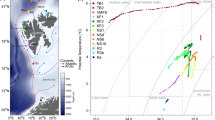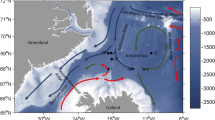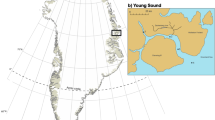Abstract
Eucalanus inermis is an abundant species in the eastern tropical and subtropical South Pacific, including the oceanic and coastal waters off Chile and Peru. Its annual life cycle was studied through a time-series sampling (weekly intervals) during 2002, at a fixed coastal station at an upwelling site (Mejillones Bay, 23°S) off northern Chile. The more-or-less continuous occurrence and abundance of naupliar and copepodid stages indicated that the species reproduces during most of the year, with two peaks: one during the austral spring and the other during the summer. Thereafter, an abrupt decline in the population was observed during winter. The abundances of E. inermis copepodids and nauplii were positively correlated with sea surface temperature, suggesting temperature-dependent development and growth during the spring–summer period. Three cohorts could be distinguished during one annual cycle, with generation times >30 days. The estimate of mean weight-specific daily growth (0.12 day−1) is lower than that of other species in the area, but it is consistent with a slower development rate. The distribution of this copepod is associated with the equatorial subsurface waters characterized by low-oxygen content (<0.5 ml l−1). The ascent of this water mass to the near-surface during coastal upwelling in the spring–summer period and the presence of E. inermis adults favor their reproduction and the development of cohorts in the food-rich upwelling environment. The wintertime disappearance of E. inermis from shallow waters is, thus, interpreted as a movement to deep waters (>200 m depth), probably in a lethargic mode, within the oxygen minimum zone in the adjacent oceanic area.








Similar content being viewed by others
References
Björnberg TKS, Lopes R, Björnberg MHGC (1994) Nauplius. Rio Grande Sul Dep Prod Anim Div Zootec Serv Exp Zootec Bol Tec 2:1–16
Blanco JL, Thomas AC, Carr M-E, Strub PT (2001) Seasonal climatology of hydrographic conditions in the upwelling region off northern Chile. J Geophys Res 106:11451–11467
Boyd CM, Smith SL (1983) Plankton, upwelling and coastal trapped waves off Peru. Deep-Sea Res 30:723–742
Boyd CM, Smith SL, Cowles TJ (1980) Grazing patterns of copepods in the upwelling system off Peru. Limnol Oceanogr 25:583–596
Daneri G, Dellarossa V, Quiñones R, Jacob B, Montero P, Ulloa O (2000) Primary production and community respiration in the Humboldt Current System off Chile and associated oceanic areas. Mar Ecol Prog Ser 197:41–49
Deevey GB (1964) Annual variations in length of copepods in the Sargasso Sea off Bermuda. J Mar Biol Assoc UK 44:589–600
Escribano R, Hidalgo P (2000a) Spatial distribution of copepods in the north of the Humboldt Current region during coastal upwelling. J Mar Biol Assoc UK 80:283–290
Escribano R, Hidalgo P (2000b) Influence of El Niño and La Niña on the population dynamics of Calanus chilensis in the Humboldt Current ecosystem of northern Chile. ICES J Mar Sci 57:1867–1874
Escribano R, McLaren IA (1999) Production of Calanus chilensis in the upwelling area of Antofagasta, northern Chile. Mar Ecol Prog Ser 177:147–156
Escribano R, Rodríguez L (1994) Life cycle of Calanus chilensis Brodsky in Bay of San Jorge, Antofagasta, Chile. Hydrobiologia 292/293:289–294
Flint MV, Drits AV, Pasternak AF (1991) Characteristic features of body composition and metabolism in some interzonal copepods. Mar Biol 111:199–205
Geynrikh AK (1973) Horizontal distribution of copepods in the Peru current region. Oceanology 13:94–103
Giraldo A, Escribano R, Marín V (2002) Spatial distribution of Calanus chilensis off Mejillones Peninsula (northern Chile): ecological consequences upon coastal upwelling. Mar Ecol Prog Ser 230:225–234
González HE, Ortiz VC, Sobarzo M (2000) The role of faecal material in the particulate organic carbon flux in the northern Humboldt Current, Chile (23°S), before and during the 1997–1998 El Niño. J Plankton Res 22:499–529
González HE, Giesecke R, Vargas C, Pavez M, Iriarte J, Santibáñez P, Castro L, Escribano R, Pagès F (2004) Carbon cycling through the pelagic food web in the northern Humboldt Current off Chile (23°S). ICES J Mar Sci 61:572–584
Heinrich AK (1973) Horizontal distribution of copepods in the Peru current region. Oceanology 13:97–103
Hidalgo P, Escribano R (2001) Succession of pelagic-copepod species during the period 1996/1998 in northern Chile: the influence of the 1997–98 El Niño. Hydrobiologia 453:153–160
Iriarte JL, Pizarro G, Troncoso VA, Sobarzo M (2000) Primary production and biomass size-fractioned phytoplankton off Antofagasta, Chile (23–24°S), during pre–El Niño and El Niño 1997. J Mar Syst 26:37–51
Johnson MW (1937) The developmental stages of the copepod Eucalanus elongatus Dana var. Bungii Giesbrech. Trans Am Microsc Soc 54:79–98
Judkins DC (1980) Vertical distribution of zooplankton in relation to the oxygen minimum off Peru. Deep-Sea Res 27A:475–487
Kimmerer WJ (1983) Direct measurement of the production:biomass ratio of the subtropical calanoid Acrocalanus inermis. J Plankton Res 5:1–14
Klein-Breteler WCM, Schogt N, Gonzalez SR (1990) On the role of food quality in grazing and development of life stages, and genetic change of body size during cultivation of pelagic copepods. J Exp Mar Biol Ecol 135:177–189
Marín V, Rodríguez L, Vallejo L, Fuenteseca J, Oyarce E (1993) Efecto de la surgencia costera sobre la productividad primaria primaveral de bahia Mejillones del Sur (Antofagasta, Chile). Rev Chil Hist Nat 66:479–491
Marín VH, Escribano R, Delgado LE, Olivares G, Hidalgo P (2001) Upwelling in a coastal site off the northern Humboldt Current System: spatial structure and biological consequences. Contin Shelf Res 21:1317–1319
Mann KH, Lazier JRN (1991) Dynamics of marine ecosystems. Blackwell, Oxford
McGowan JA, Walker PW (1985) Dominance and diversity maintenance in an oceanic ecosystem. Ecol Monogr 55:103–118
Morales CE, Blanco J, Braun M, Reyes H, Silva N (1996) Chlorophyll a distribution and associated oceanographic conditions in the upwelling region off northern Chile: winter and spring 1993. Deep-Sea Res 43:267–289
Morales CE, Hormazabal SE, Blanco JL (1999) Interannual variability in the mesoscale distribution of the depth of the upper boundary of the oxygen minimum layer off northern Chile (18–24S): implications for the pelagic system and biogeochemical cycling. J Mar Res 57:909–932
Ohman MD, Runge JF (1994) Sustained fecundity when phytoplankton resources are in short supply: omnivory by Calanus finmarchicus in the Gulf of St. Lawrence. Limnol Oceanogr 39:21–36
Parsons TR, Maita Y, Lalli CM (1984) A manual of chemical and biological methods for seawater analysis. Pergamon, Oxford
Rodríguez L, Castro L (2000) Estudios en ecología de larvas de Mictofidos (Pisces, Myctophidae): una propuesta para nuevas líneas de investigación en la Corriente de Humboldt. Gayana Zool 64:219–233
Rodríguez L, Zarate O, Oyarce E (1986) Producción primaria del fitoplancton y su relación con la temperatura, nutrientes, oxígeno y salinidad en la bahía de Mejillones deo Sur. Rev Biol Mar 22:75–96
Rojas P, Escribano R, Marin V (2002) The influence of coastal upwelling on fish larvae distribution off Mejillones Peninsula, northern Chile. Fish Oceanogr 11:233–244
Saltzman J, Wishner K (1997) Zooplankton ecology in the eastern tropical Pacific oxygen minimum zone above a seamount. 2. Vertical distribution of copepods. Deep-Sea Res 44:931–954
Sameoto DD (1986) Influence of the biological and physical environment on the vertical distribution of mesozooplankton and micronekton in the eastern tropical Pacific. Mar Biol 93:263–279
Sherman K (1990) Productivity, perturbations and options for biomass yield in large marine ecosystems. In: Sherman K, Alexander LM, Gold BD (eds) Large marine ecosystems: patterns, processes and yields. American Association for the Advancement of Science, Washington DC, pp 206–219
Sobarzo M, Figueroa D (2001) The physical structure of a cold filament in a Chilean upwelling zone Península Mejillones, Chile (23°S). Deep-Sea Res Part I 48:2699–2726
Ulloa O, Escribano R, Hormazabal S, Quiñones R, Ramos M, Gonzalez R (2001) Evolution and biological effects of the 1997–98 El Niño in northern Chile. Geophys Res Lett 28:1591–1594
Acknowledgements
This study has been funded by the FONDAP Program of CONICYT-Chile and is a contribution from the Center of Oceanographic Research in the eastern South Pacific (COPAS). P. Hidalgo was supported by a Graduate Scholarship from CONICYT-Chile. We are grateful to the Universidad de Antofagasta for providing support to carry out the field work and to L. Figueroa, M. Rojo and M. Oliva for their valuable help in the field. We are indebted to two anonymous reviewers, whose comments helped clarify ideas. We also thank A. Davis for revising the MS. This work is a contribution to the GLOBEC-Chile National Program.
Author information
Authors and Affiliations
Corresponding author
Additional information
Communicated by P.W. Sammarco, Chauvin
Rights and permissions
About this article
Cite this article
Hidalgo, P., Escribano, R. & Morales, C.E. Annual life cycle of the copepod Eucalanus inermis at a coastal upwelling site off Mejillones (23°S), northern Chile. Marine Biology 146, 995–1003 (2005). https://doi.org/10.1007/s00227-004-1487-3
Received:
Accepted:
Published:
Issue Date:
DOI: https://doi.org/10.1007/s00227-004-1487-3




